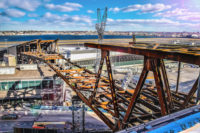A$190-million runway and taxiway reconstruction project at Indianapolis International Airport features the first-ever Federal Aviation Administration-approved use of a carbon capture technology in the pavement. The project is the first of its kind to receive Envision Platinum certification.
The project uses CarbonCure, a technology that introduces recycled CO2 into fresh concrete to reduce its carbon footprint without compromising performance. Once injected, the CO2 undergoes mineralization and is permanently embedded.
The 22-in. top concrete layer will contain the waste CO2, and the amount of carbon being sequestered is the equivalent of planting 1.2 million trees, according to Indianapolis Airport Authority senior planning and development director Jarod Klaas. Circle City Aviation Partners, a joint venture of Woolpert and Kimley-Horn, reached out to CarbonCure and the FAA in hopes of doing a test section, says Nathan Summers, Kimley-Horn project manager. The FAA then approved reconstructing the entire 10,000-ft-long, 150-ft-wide runway with it, he recalls.
Walsh Construction is wrapping up its $69.5-million contract to build the project’s first phase, with work including 240,000 sq yd of concrete removal and replacement, placement of 106,500 sq yd of new asphalt, 115,300 cu yd of earthwork utility work, drainage and airfield signs, says Brian Hoppel, Walsh program manager. While the carbon is injected into the concrete mix during the batching, “there was no difference in the field and in actual placement,” he says. “We recycled the existing concrete, crushed it and used it in stone base, beneath the new pavement.”
The 22-in. top concrete layer is followed by 5 in. of asphalt, 6 in. of recycled aggregate base and 8 in. of cement-treated subgrade, says Summers. The 30-year-old runway will have a life expectancy of 40 years rather than 20 due in part to discussions with FedEx and an analysis that resulted in increasing the pavement depth by an inch.
CarbonCure has been used in the vertical industry for some time, says Gary Mitchell, chief of engineering and construction with the American Concrete Pavement Association, which provided constructability and specification reviews for Circle City Aviation Partners. “To date, CarbonCure has delivered over three million truckloads of concrete with carbon mineralization. That has resulted in over 200,000 metric tons of carbon savings,” Mitchell notes. However, “we were not aware of any pavements in the U.S. that had used the process at the time carbon capture came up at Indianapolis.”
The other half of the runway will be completed over the next two construction seasons, with Milestone Contractors to begin work next year, says John Bayer, Woolpert senior project manager. One side bonus of CarbonCure is that “it is one thing we haven’t seen any supply issues with or had any challenges from a constructability standpoint,” he says.
Going Greener
The project is funded in part by a $56.3-million federal grant for sustainable infrastructure from the FAA in 2021, the largest of a total $431.8 million awarded. CarbonCure and recycled concrete are just a part of the airport’s sustainability efforts, which include a goal of net zero by 2050. To take advantage of the shutdown of the reconstructed runway, the authority plans an installation of a 1,000-kW direct current solar PV system and battery storage on the airfield. All replaced airfield signs and lighting will be recycled for use at other area airports, says J.J. Morton, Kimley-Horn principal.
Bayer also emphasizes the team’s mentoring and collaboration with minority-owned firms. “We’re not looking for partners just to meet a goal but partners that provide specific values and skillsets for the project and opportunities to mentor those firms.”
Loftus Engineering, a mechanical and electrical engineering firm, expanded its services to include runway lighting and power, says president Karen Loftus. “It was definitely a new opportunity and we hope to pursue other [runway] work.”






Post a comment to this article
Report Abusive Comment